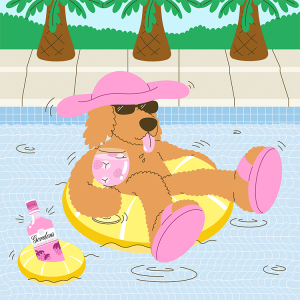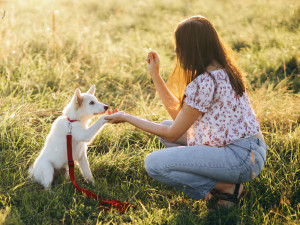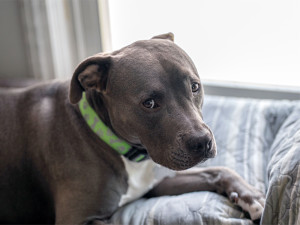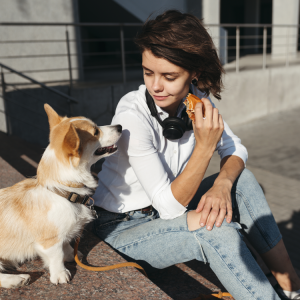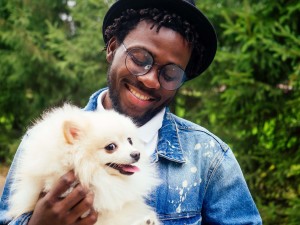Are Dogs Actually Stubborn?
“Labeling a dog as stubborn is often an easy way to shift the blame from a problem with the relationship to a problem with the dog.”

Share Article
Note: The names of the pet parents in this story have been changed in this article to protect their privacy.
“Come on,” says my friend Tim, to his 11-year-old Pekinese, Brisket, as we attempt to take him for a walk. Brisket is surprisingly spry for such an old dog, but he is refusing to move at the moment. “Brisket, please!” Tim pleads. “Please! Daddy doesn’t have time for this. Ugh!”
“Do you have any treats?” I ask, trying to be helpful.
“No,” he says. “He’s just like this. He’s stubborn, that’s all. Brisket, let’s go!”

But is that all? Perhaps there is some issue Brisket is dealing with, something he needs, that my friend isn’t aware of. Are dogs even capable of being stubborn or is the idea that they are just another example of dog anthropomorphism? Maybe it’s not Brisket who's being stubborn but my friend. After all, he reacts the same way every time Brisket stops walking, complaining at him in various degrees of distress and refusing to invest in training or try a different approach to the problem.
Stubbornness happens for a lot of reasons.
“‘Stubborn’ is a label we apply to dogs when they either don’t respond as expected or are taking too long to do what we want,” says Nicole Kohanskiopens in new tab, certified dog trainer and founder of Wiggle Butt Academyopens in new tab in Dallas, Texas. “Why a dog behaves this way can be due to fear, confusion, or a lack of motivation.”
Maybe Brisket didn’t like the way we were leading him on his walk. Or maybe he smelled something nearby that he wasn’t into. Maybe he thought we were going to go one way, because that’s the way Tim usually takes him, and got confused when we went another way. Maybe he just needed to be given some treats to motivate him during his walk, instead of after his walk, as is Tim’s habit.
Whatever the case, it’s important to realize that nothing Brisket or any dog does is ever premeditated. Dogs do not plan their behaviors in advance. They do not act out of spite or hold grudges. “Dogs act in the moment and respond to the events going on around them,” says Sally Grottini, a certified therapy and service dog trainer and dog behavior expert at JustAnsweropens in new tab. “This is not a behavior they are choosing; it is always the initial instinct of the dog. And calling a dog stubborn is 100 percent the owner projecting their language and impressions on the dog.”
“My dog [Gollum] is definitely stubborn,” says another friend of mine, Fern, when I tell her I was working on this story.
“Well, have you trained him properly,” I ask.
“Oh no,” she says with a laugh. “He’s trained us.”
“Except that dog’s don’t actually train people,” I say. “Their brains don’t work like that. You just haven’t put in the time and effort to train him. Well, you have, but not consciously. If he’s developed certain behavioral habits, it’s because you’ve been reinforcing them, not because he’s willful.”
“So, it’s my fault?” she says, defensively. “Well, now you’re making me feel bad.”
That was certainly not my intention, but I can’t say that I was surprised by her defensiveness. Rare is the pet parent who doesn’t get at least a little defensive when they feel that they are being told that they are not doing enough for their dog. Even still, my friends know there are other dogs who don’t behave like theirs do. They know there are dogs who are better trained. But admitting that would make them feel bad about themselves, so, instead, they push the blame onto their dogs, calling them stubborn so they don’t have to take responsibility.
Labels are masking something deeper.
“Labeling a dog as stubborn is often an easy way to shift the blame from a problem with the relationship to a problem with the dog,” says Georgia Welchopens in new tab, National Pet Training Manager at Invisible Fence® Brandopens in new tab. “But it’s important for pet parents to understand that when a dog fails to comply, it is more likely a failure of communication or relationship as opposed to the dog’s obstinance. For instance, a dog might fail to comply because they think the command is optional. And they think that because their training has been inconsistent.”
Although I am not with Fern or Tim all the time, I’m with them enough to know that their responses to their dogs’ behavior can change drastically depending on their mood. And while this is understandable, it does result in inconsistent enforcement of cues and a wide range of reactions to certain behaviors, which I imagine must be confusing for their dogs.
Another consistent obstacle to dog compliance is an excess of negative reinforcement. For instance, if every time a dog is told to “come,” it is because they are in trouble and are going to get yelled at or punished, it is unlikely that they are going to want to obey that cue. Dogs, like people, have a primal need to protect themselves.
If your boss only called you into their office to complain about your work, you would learn to associate “Can I see you in my office?” with feeling bad. Then, every time you hear that in the future, you’ll get a sinking feeling and not want to go to that meeting. You’re a human adult, so you will probably muster up the courage to go anyway, but dogs don’t operate like that.
Keep things positive.
If you want them to obey your cues, switch to positive reinforcement. Rather than sounding angry, “put a party in your voice,” as the character Rose says in Lauren Holmes’ award-winning dog-park play, opens in new tab Zeus IV. When they come to you, instead of yelling at them for what they were doing before you called them over, offer them a treat for complying when you did. Punishing a dog only teaches them that you are someone to be feared and avoided and is always more about you releasing your anger and frustration than it is about actually training your dog to do what you need them to do.
“Often, people assume their dogs are stubborn because they don’t understand how dogs learn,” Welch says. “People are contextual learners. If you learn to read at school, you can also read at home or at the beach. But dogs are situational learners. Learning to sit at home is different from sitting at the park, which is different from sitting at the vet office. This leads to frustrations for both dogs and humans.”
“If you find yourself getting frustrated, take some action,” Kohanski says. “Have some fun practicing the cue with your dog and pair it with lots of fun and reinforcement, like treats, praise, and pets.”
She adds that you can then up the motivation. Identify your dog’s motivators — like high-reward treats, physical touch and praise, or anything else they enjoy. And reward them frequently, especially when they are doing something they love.
Here’s Kohanski’s advice: “If your dog loves being outside, but every time you call him is to bring him indoors, he may appear stubborn about recall. So, instead, try calling him from short distances within the yard, then giving him a treat or some other form of positive reinforcement, and releasing him to play some more. This will teach him that coming to you doesn’t always mean bad things and should lead to better compliance.”
Changing your dog’s behavior is possible, but it takes time, and you won’t succeed if you’re not willing to make some changes as well. That might sound scary, but, on the upside, the kind of positive training discussed above is exactly the thing that strengthens the bond between human and dog. If you think you and your dog are close now, just wait until you two are communicating clearly and positively. The difference will be life-changing. For both of you.

Charles Manning
Charles Manning is an actor and writer based in New York City. In his free time he likes to cook, go swimming at the public pool, volunteer at the LGBTQ senior center, and foster senior and special-needs cats. His work has previously appeared in Cosmopolitan, Elle, Marie Claire, Harper’s Bazaar, Seventeen, and Nylon.
Related articles
No, Your Dog Does Not Feel Guilt—Here’s What Those “Regretful” Looks Really Mean
Your pup doesn’t actually feel bad about eating your pizza.
![corgi giving woman puppy dog eyes begging for food]()
A New Study Debunks the Theory That “Puppy Dog Eyes” Are for Humans’ Benefit
Apparently wild dogs can be pretty cute, too.
![Man hugging his fluffy white dog happily]()
Chemistry Between People and Dogs Is Real (It’s Science)
How the “love hormone” oxytocin connects us with our pups.
![]()
To Cry Is Human—and Apparently Canine
Time to whip out The Notebook for a little doggie movie night.
![A woman sitting on a floor playing with her dogs.]()
How to Know if Your Dog Has Imprinted on You
If they’re following you around like your shadow, there’s a reason for that.
![Young blonde woman with a Jack Russell puppy during spring in the city.]()
The Best Training Treats for Dogs in 2025
The most mouth-watering treats for training your pup.


